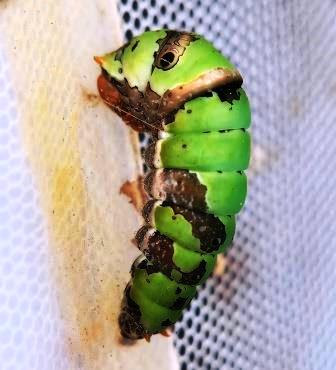Synonyms. Leptoglossus australis (Fabricius), Leptoglossus membranaceus (Fabricius)
Family. Coreidae
Order. Hemiptera
Common name. Squash bug, kepik labu (Indonesia)
Distribution. Leptoglossus gonagra is found in Africa, the Caribbean, Central America, North America, Southern Asia, Micronesia, and the tropical and subtropical regions of Australia.
Host plants. Leptoglossus gonagra is a polyphagous insect known to feed on various plants, including snake gourd, melon, cucumber, pumpkin, and other cucurbits. Additionally, it has been reported to feed on citrus, eggplant, guava, legumes, passionfruit, and tomato.
Description and biology. Adults of this species are typically 18-24 mm long and have a black or dark brown coloration. They can be recognized by a curved orange line behind their head, as well as their long, banded antennae that feature black and orange stripes (Figure 1).
 |
| Figure 1. Leaf-footed bug Leptoglossus gonagra (Photo: © Aunu Rauf) |
Additionally, the underside of their thorax and abdomen have small orange spots, while their rear legs are enlarged and flattened, and each of the two tibiae has a pair of orange spots (Figure 2).

Figure 2. Leptoglossus gonagra (Photo: © Aunu Rauf)
The female insects lay their eggs in batches of approximately 30 on the leaves, stems, and even the tendrils of the plant. After 6-7 days, the eggs hatch into nymphs. The nymphs go through five stages over 40-50 days. Initially, the young nymphs are reddish in color, but as they progress from one molt to the next, they become darker. They tend to cluster together in the beginning but gradually disperse more widely around the plant.
Nature of damage. Damage is caused by both nymphs and adult sucking sap from stems and tender fruits. Stems turn yellow-brown and they may die if infestations are high. Feeding on fruits causes them to shrivel, rot and drop. Secondary fungal infection by Nematospora may occur on citrus fruits. The bugs are not considered major pests, and only occasionally reach numbers that cause economic damage.
Natural enemies. Little is known about its natural enemies.
Butani DK. 1979. Insects and Fruits. Delhi: Periodical Expert Book Agency.
Fondio D, Yeboue NL, Soro S, Tano DKC. 2020. Biological parameters of Leptoglossus membranaceus Fabricius. 1781 (Heteroptera: Coreidae) cucumber pest (Tokyo F1 and poinsett varieties) in the rainy season in Daloa (Cote d'Ivoire). J Entomol Zool Studies 8(2): 1618-1624.
Kalshoven LGE. 1981. Pests of crops in Indonesia, (Revised and translated by PA van der Laan). Jakarta: PT Ichtiar Baru.
Shepard BM, Carner GR, Barrion AT, Ooi PAC, van den Berg H. 1999. Insects and their natural enemies associated with vegetables and soybean in Southeast Asia. Orangeburg (SC), USA: Quality Printing Company.
van Reenen JA. 1973. Behaviour and biology of Leptoglossus membranaceus (Fabricius) in the Transvaal, with description of the genitalia (Heteroptera: Coreidae). Annals of The Transvaal Museum 28(14): 257-286.


































